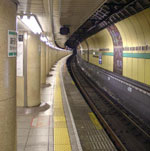
Tokyo Metro stations are renowned for their cleanliness

FRONT PAGE
Site Search
About us
Directories

Barcelona Metro
Berlin U-Bahn
Guangzhou Metro
Guatemala City TransMetro
London Transport
London Underground
Madrid Metro
Mexico City Metrobus
New York City Subway
Paris Métro
Sao Paulo Metro
Singapore Metro
Tokyo Metro
Bus Rapid Transport Latin America
Bus Rapid Transport India
Trams in Europe

Worldwide | Elections | North America | Latin America | Europe | Asia | Africa |
























|
|
Tokyo Metro: The world’s cleanest
and most extensive subway system
By Andrew Stevens
9 February 2006: The world’s largest, Tokyo’s Metro achieved considerable prominence in 1995 following the poison gas attack on the network by the religious cult Aum Shinrikyo. Tokyo’s dense public transport network is comparable to those in its sister global cities of London, New York and Paris, surpassing them in many regards. Its first line opened in 1927 during the capital’s rapid urbanisation and today operates 21 lines owned by two principal operating companies. In addition to the subway, a number of monorail, tram and private lines also serve the city.
History | Design | User experience | Ownership | Expansion | Comparisons |
History
Today’s Tokyo Metro Company Ltd began as the Teito Rapid Transit Authority (TRTA) in 1941, though this replaced the private railway which had opened in 1927 on the Ginza line. Major expansion then took place with the opening of the Marunouchi line in 1954 and a steady increase in the number of lines built since then, with many extensions due for completion. The TRTA was transferred to the new company in 2004. Having previously been administered by the Ministry of Land, Infrastructure and Transport, it is now jointly owned by the Ministry and Tokyo Metropolitan Government.
Two separate companies are responsible for the whole of the Tokyo network. In addition to Tokyo Metro, the Tokyo Metropolitan Bureau of Transportation (known as ‘Toei’) also runs four lines, as well as the city’s only surviving tramline, the Toden Arakawa. Tickets purchased for lines operated by one are not transferable to the other. The Toei lines, owned by the Metropolitan Government, are the last to be built.
The flagship Tokyo Bay development is also served by a driver-less rapid transit network, connected to mainline and metro stations. The Tokyo Monorail, opened for the 1964 Olympic Games, consists of four stations and connects Haneda Airport with one JR station.
Design & layout
Arguably the most comprehensive metro system in the world, Tokyo’s complex array of lines cover most districts in the 23 Tokyo wards and also reach out into the suburbs. Both stations and rolling stock are largely uniform and highly modern, as befits external perceptions.
User experience
As many can attest, travelling on the Tokyo Metro lines is an essential experience for anyone visiting the city, for even the briefest of visits. The experience is wide ranging, though confusing at first due to the ticketing issues alluded to. Visitors can marvel at the ultra-modern appearance of much of the network or be baffled by the sight of young men openly reading cartoon porn during the rush hour. However, trains are extremely punctual and clean and all information is also presented in English, even station announcements. Crime is almost unknown on the network, as is vandalism. Prices are modest and begin at Y160 (US$1.35) for a single journey, with an all-month all-lines pass costing Y16,820.
Ownership
Two separate companies are responsible for the whole of the Tokyo network. In addition to Tokyo Metro Co. Ltd, the Tokyo Metropolitan Bureau of Transportation also runs four lines. The Tokyo Metropolitan Bureau of Transportation also acts as transit authority and runs the city’s bus services.
Future expansion
An 8.9km extension of the Yurakucho line is due for completion in 2007.
National comparisons
Several large cities in Japan operate subway systems, principally Fukuoka, Kobe, Kyoto, Nagoya, Osaka, Sapparo, Sendai and Yokohama. Cities such as Chiba, Kitakyushu and Naha operate monorails while Hiroshima maintains an extensive tramway system.
|
|

|





























